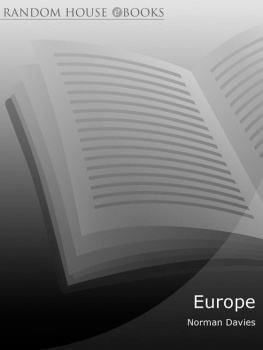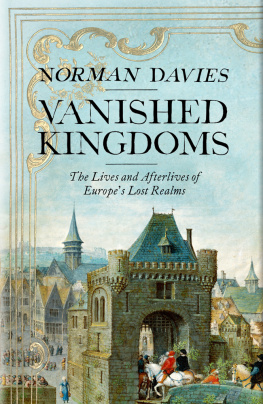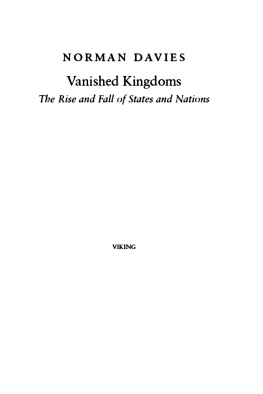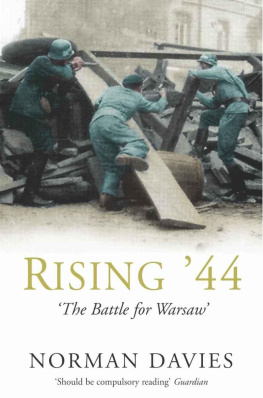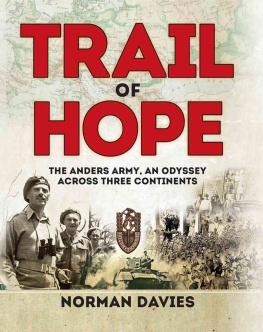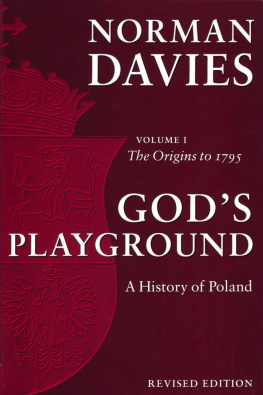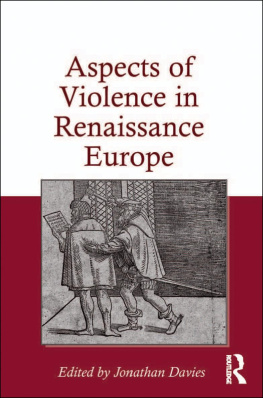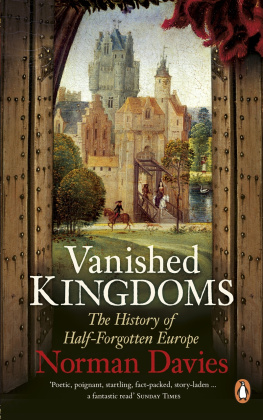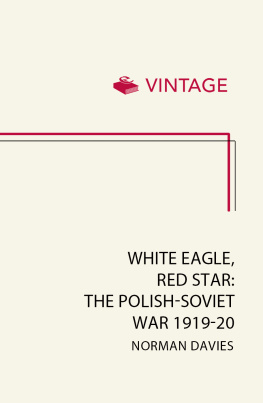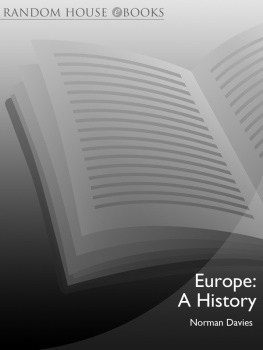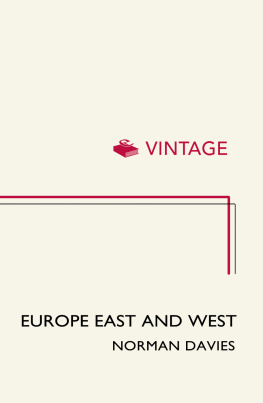Norman Davies - Europe: A History
Here you can read online Norman Davies - Europe: A History full text of the book (entire story) in english for free. Download pdf and epub, get meaning, cover and reviews about this ebook. year: 1997, publisher: Pimlico, genre: Religion. Description of the work, (preface) as well as reviews are available. Best literature library LitArk.com created for fans of good reading and offers a wide selection of genres:
Romance novel
Science fiction
Adventure
Detective
Science
History
Home and family
Prose
Art
Politics
Computer
Non-fiction
Religion
Business
Children
Humor
Choose a favorite category and find really read worthwhile books. Enjoy immersion in the world of imagination, feel the emotions of the characters or learn something new for yourself, make an fascinating discovery.
- Book:Europe: A History
- Author:
- Publisher:Pimlico
- Genre:
- Year:1997
- Rating:5 / 5
- Favourites:Add to favourites
- Your mark:
- 100
- 1
- 2
- 3
- 4
- 5
Europe: A History: summary, description and annotation
We offer to read an annotation, description, summary or preface (depends on what the author of the book "Europe: A History" wrote himself). If you haven't found the necessary information about the book — write in the comments, we will try to find it.
Europe: A History — read online for free the complete book (whole text) full work
Below is the text of the book, divided by pages. System saving the place of the last page read, allows you to conveniently read the book "Europe: A History" online for free, without having to search again every time where you left off. Put a bookmark, and you can go to the page where you finished reading at any time.
Font size:
Interval:
Bookmark:
A History

NORMAN DAVIES

This eBook is copyright material and must not be copied, reproduced, transferred, distributed, leased, licensed or publicly performed or used in any way except as specifically permitted in writing by the publishers, as allowed under the terms and conditions under which it was purchased or as strictly permitted by applicable copyright law. Any unauthorised distribution or use of this text may be a direct infringement of the authors and publishers rights and those responsible may be liable in law accordingly.
Version 1.0
Epub ISBN 9781407091792
www.randomhouse.co.uk
Published by Pimlico 1997
Copyright Norman Davies 1996
Reprinted with corrections, 1997
Norman Davies has asserted his right under the Copyright, Designs and Patents Act, 1988 to be identified as the author if this work
This book is sold subject to the condition that it shall not, by way of trade or otherwise, be lent, resold, hired out, or otherwise circulated without the publishers prior consent in any form of binding or cover other than that in which it is published and without a similar condition including this condition being imposed on the subsequent purchaser
First published by Oxford University Press in 1996
Pimlico Random House
20 Vauxhall Bridge Road, London SW1V 2SA
www.rbooks.co.uk
Addresses for companies within The Random House Group Limited can be found at: www.randomhouse.co.uk/offices.htm
Random House UK Ltd Reg. No. 954009
A CIP catalogue record for this book is available from the British Library
ISBN 9780712666336
The Random House Group Limited supports The Forest Stewardship Council (FSC), the leading international forest certification organisation. All our titles that are printed on Greenpeace approved FSC certified paper carry the FSC logo. Our paper procurement policy can be found at:
www.rbooks.co.uk/environment
Printed in the UK by CPI William Clowes Beccles NR34 7TL
For Christian
Our Californian
PIMLICO
EUROPE
Norman Davies is Professor Emeritus of the University of London, a Senior Member of Wolfson College, Oxford, and the author of several books on European history, including Gods Playground and Heart of Europe.
PREFACE
T HIS book contains little that is original. Since most aspects of the subject have been thoroughly worked over by previous historians, primary research was rarely required. The books originality, such as it is, lies only in the selection, rearrangement, and presentation of the contents. The main aim was to map out a grid of time and space for European history and, by introducing a sufficiently comprehensive range of topics into the framework, to convey an impression of the unattainable whole.
The academic apparatus has been kept to a minimum. There are no notes relating to facts and statements that can be found in any of the established works of reference. Among the latter, special mention must be made of my twenty-nine volumes of The Encyclopaedia Britannica (11th edn., 191011), which far surpasses all its successors. Endnotes are only provided to substantiate less familiar quotations and sources of information beyond the range of the standard textbooks. One should not assume that the text necessarily agrees with interpretations found in the works cited: On ne stonnera pas que la doctrine expose dans le texte ne soit toujours daccord avec les travaux auxquels il est renvoy en note.
The academic considerations which underlay the writing of the present volume have been set out in the Introduction. But its design may need some explanation.
The text has been constructed on several different levels. Twelve narrative chapters pan across the whole of Europes past, from prehistory to the present. They gradually zoom in from the distant focus of Chapter I, which covers the first five million years, to the relatively close focus of Chapters XI and XII, which cover the twentieth century at roughly one page per year. Each chapter carries a selection of more specific capsules, picked out, as it were, by telephoto, and illustrating narrower themes that cut across the chronological flow. Each chapter ends with a wide-angle snapshot of the whole Continent as seen from one particular vantage-point. The overall effect may be likened to a historical picture album, in which panoramic tableaux are interspersed by a collection of detailed insets and close-ups. One hopes it is understood that the degree of precision attainable at these different levels will vary considerably. Indeed, a work of synthesis cannot expect to match the standards of scientific monographs that have rather different purposes in mind.
The twelve main chapters follow the conventional framework of European history. They provide the basic chronological and geographical grid into which all the other topics and subjects have been fitted. They concentrate on event-based history: on the principal political divisions, cultural movements, and socio-economic trends which enable historians to break the mass of information into manageable (though necessarily artificial) units. The chronological emphasis lies on the medieval and modern periods, where a recognizably European community can be seen to be operating. The geographical spread aims to give equitable coverage to all parts of the European Peninsula from the Atlantic to the Urals north, east, west, south, and centre.
At every stage, an attempt has been made to counteract the bias of Eurocentrism and Western civilization (see Introduction, pp. 1619,1931). But in a work of this scope it has not been possible to extend the narrative beyond Europes own frontiers. Suitable signals have been made to indicate the great importance of contingent subjects such as Islam, colonialism, or Europe overseas. East European affairs are given their proper prominence. Wherever appropriate, they are integrated into the major themes which affect the whole of the Continent. An eastern element is included in the exposition of topics such as the Barbarian invasions, the Renaissance, or the French Revolution, which all too often have been presented as relevant only to the West. The space given to the Slavs can be attributed to the fact that they form the largest of Europes ethnic families. National histories are regularly summarized; but attention has been paid to the stateless nations, not just to the nation-states. Minority communities, from heretics and lepers to Jews, Romanies, and Muslims, have not been forgotten.
In the last chapters, the priorities of the Allied scheme of history have not been followed (see Introduction, pp. 3942). Nor have they been polemically contested. The two World Wars have been treated as two successive acts of a single drama, preference being given to the central continental contest between Germany and Russia. The final chapter on post-war Europe takes the narrative to the events of 198991 and the disintegration of the Soviet Union. The argument contends that 1991 saw the end of a geopolitical arena, dubbed the Great Triangle, whose origins can be dated to the turn of the twentieth century (see Appendix III, p. 1312), and whose demise offers a suitable hiatus in a continuing story. The approach of the twenty-first century sees the opening of a new opportunity to design a new Europe.
The capsules, of which there are some 300 (see Map 30 and Appendix I), perform several purposes. They draw attention to a wide variety of specifics which would otherwise find no place among the generalizations and simplifications of synthetic history-writing. They sometimes introduce topics which cross the boundaries of the main chapters; and they illustrate all the curiosities, whimsies, and inconsequential sidestreams which over-serious historians can often overlook. Above all, they have been selected to give as many glimpses as possible of the new methods, the new disciplines, and the new fields of recent research. They provide samples from some sixty categories of knowledge, which have been distributed over the chapters in the widest possible scatter of period, location, and subject-matter. For arbitrary reasons of the books length, the publishers patience, and the authors stamina, the original capsule list had to be reduced. None the less, it is hoped that the overall pointilliste technique will still create an effective impression, even with a smaller number of points.
Font size:
Interval:
Bookmark:
Similar books «Europe: A History»
Look at similar books to Europe: A History. We have selected literature similar in name and meaning in the hope of providing readers with more options to find new, interesting, not yet read works.
Discussion, reviews of the book Europe: A History and just readers' own opinions. Leave your comments, write what you think about the work, its meaning or the main characters. Specify what exactly you liked and what you didn't like, and why you think so.

